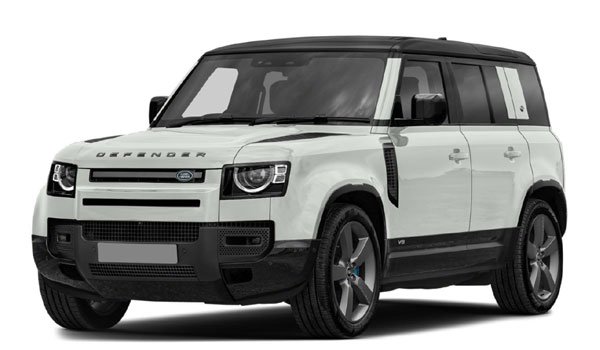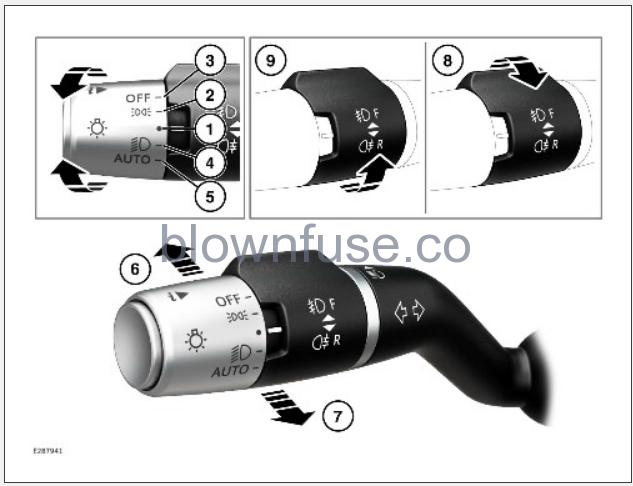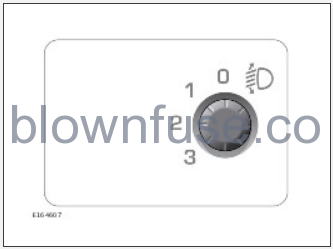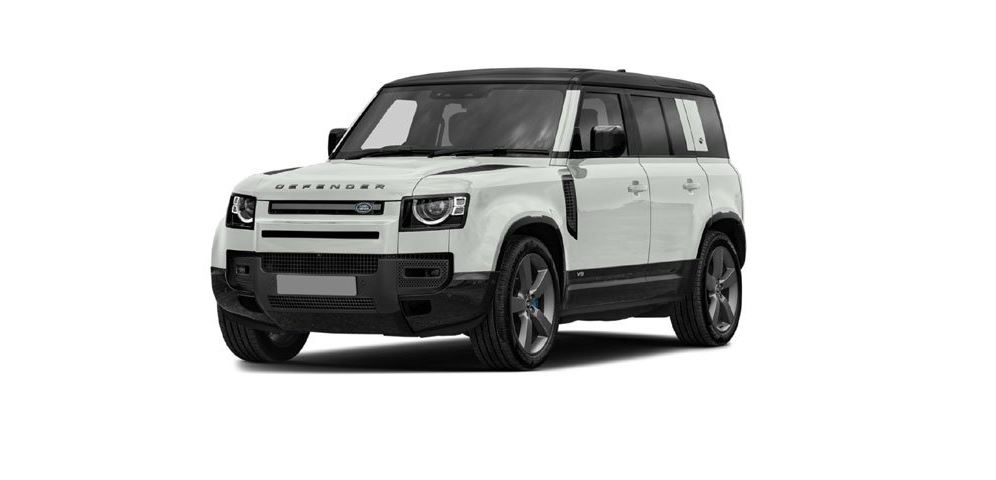 2023 Land Rover DEFENDER EXTERIOR LIGHTS
2023 Land Rover DEFENDER EXTERIOR LIGHTS

EXTERIOR LIGHTS OVERVIEW
The exterior lights operate automatically depending on the ambient lighting conditions.
A number of different features are available. The system automatically selects an appropriate feature, based on vehicle and ambient conditions. It may be necessary to manually override these features in some circumstances.
Some manual operations may not be possible due to vehicle activity or legislative requirements.
LIGHTING CONTROL
The lighting control is located to the left of the steering wheel.
Move the lighting control in the appropriate direction to select the desired function. Once released, the lighting control returns to the neutral position.

- Neutral position.
- Side lights.
- OFF.
- Dipped beam headlights.
- AUTO mode.
- High beam headlights.
- High beam headlights flash.
- Rear fog lights.
- Front fog lights.
The lighting control returns to the neutral position after a manual lighting selection is made.
Rotate the lighting control to position (2) to switch the side lights on. The instrument panel warning lamp illuminates to confirm the selection. See SIDE LIGHTS (GREEN).
Rotate the lighting control to position (3) to manually switch off all exterior lights. The instrument panel extinguishes all related warning lamps.
Rotate the lighting control to position (4) to switch the dipped beam headlights on. The instrument panel warning lamp illuminates to confirm the selection. See DIPPED BEAM (GREEN).
Rotate the lighting control to position (5) to select AUTO mode. When AUTO mode is selected, the following lighting features are enabled:
- Daytime Running Lamps (DRL). See DAYTIME RUNNING LIGHTS (DRL) .
- Headlight courtesy delay. See HEADLIGHT COURTESY DELAY.
- Adaptive Front lighting System (AFS). See ADAPTIVE FRONT LIGHTING SYSTEM (AFS).
- Adaptive Driving Beam. See ADAPTIVE DRIVING BEAM (ADB).
AUTO mode is only active when the vehicle’s ignition is switched on and a drive gear is selected.
The instrument panel warning lamp illuminates to confirm the selection. See AUTO LIGHTS (WHITE) .
Low ambient light levels may also cause AUTO mode to activate.
With the dipped beam headlights switched on, push the control forward (6) and release. The high beam headlights illuminate. The instrument panel warning lamp also illuminates to confirm the selection. See HIGH BEAM (BLUE).
Push the control forward a second time, and release, to switch the high beam headlights off. The instrument panel warning lamp extinguishes.
Do not use the high beam headlights where they may distract other road users. Misuse of the high beam headlights could lead to an accident, potentially causing serious injury or death.
Pull the lighting control back (7), and release, to flash the high beam headlights. The instrument panel warning lamp illuminates while the lighting control is held in the flash position.
Rotate the collar (8) towards the steering wheel, and release, to switch the rear fog lights on. The instrument panel warning lamp illuminates to confirm the selection. See REAR FOG LIGHTS (YELLOW).
Rotate the collar towards the steering wheel, and release, a second time to switch the rear fog lights off. The instrument panel warning lamp extinguishes.
The rear fog lights only operate if the side lights or dipped beam headlights are switched on.
Rotate the collar (9) away from the steering wheel, and release, to switch the front fog lights on. The instrument panel warning lamp illuminates to confirm the selection. See FRONT FOG LIGHTS (GREEN).
Rotate the collar away from the steering wheel, and release, a second time to switch the front fog lights off. The instrument panel warning lamp extinguishes.
The front fog lights only operate if the side lights or dipped beam headlights are switched on.
AUTO mode is switched off if the front fog lights are switched on.
EXTERIOR LIGHTS CONDENSATION
Condensation in the exterior lights is a natural phenomenon. Condensation can occur under certain atmospheric conditions, or after washing the vehicle. The performance and life expectancy of the lights is not affected.
Condensation should partially or fully clear with regular use of the lights, and within 48 hours of dry atmospheric conditions.
LED lights emit less heat than halogen or xenon lights, and may take longer to clear. The performance of the lights is not affected.
DAYTIME RUNNING LIGHTS (DRL)
The Daytime Running Lamps (DRLs) illuminate during normal daylight conditions in order to make the vehicle more visible to other road users.
The DRLs illuminate automatically when the following conditions are met:
- AUTO mode is active. See LIGHTING CONTROL.
- High ambient light levels are detected.
- The engine is running.
- A drive gear is selected.
Rotate the lighting control to the OFF position, with the vehicle stationary and the engine running to turn the DRL off.
The DRL will automatically switch back on if:
- The vehicle’s speed rises above 10 km/h (6 mph).
- The vehicle travels more than 100 m (109 yards).
HEADLIGHT COURTESY DELAY
The headlight courtesy delay feature illuminates the headlights for a period of time after the vehicle has been switched off.
Headlight courtesy delay operates when the following conditions are met:
- AUTO mode is active. See LIGHTING CONTROL.
- Low ambient light levels are detected.
- The vehicle’s ignition is switched off.
The delay period can be adjusted via the touchscreen. To adjust the delay period:
- Touch the settings icon.¹
- Select ALL.
- Select Vehicle.
- Select Exterior lights.
- Select Headlight delay.
- Select a time delay option.
- Touch the exit icon.²
Settings icon.¹
Exit icon.²
Press the headlight button on the smart key to switch the courtesy delay headlights off. See SMART KEY OPERATION.
DRIVING ABROAD
Headlight alignment must be correct for the country in which the vehicle is travelling. In some instances the headlights must be realigned if travelling in a country where the direction of traffic is on the opposite side of the road. The need for realignment is dependent on the type of headlight fitted to the vehicle.
Correct headlight alignment is a legal requirement.
Failure to adjust the headlights may result in the dazzling of oncoming drivers, which could lead to an accident, potentially causing serious injury or death.
Vehicles with LED and Premium LED headlights have a beam pattern that eliminates the need for re-alignment.
The navigation system automatically realigns the Matrix LED headlights based on GPS data.
Automatic realignment of the Matrix LED headlights can be overridden via the touchscreen as follows:
- Touch the settings icon.¹
- Select All.
- Select Vehicle.
- Select Exterior lights.
- Select Driving side.
- Select a driving side option.
- Touch the exit icon.²
Settings icon.¹
Exit icon.²
The automatic headlight alignment setting is re-applied at the start of each new vehicle ignition cycle.
AUTO HIGH BEAM ASSIST (AHBA)
Auto High Beam Assist (AHBA) automatically selects and deselects the high beam headlights based on various light readings, including:
- Ambient lighting.
- Road lighting.
- Lighting from oncoming vehicles.
AHBA must not be relied on to react correctly in all circumstances. The driver remains responsible for the correct use of the headlights at all times. Incorrect use of the headlights could lead to an accident, potentially causing serious injury or death.
AHBA uses sensors mounted on the rear of the rear-view mirror. Keep this area of the vehicle clean and free from obstructions, e.g. stickers, debris, mud, snow, or ice. Failure to do so may lead to sensor miscalculations, which could lead to an accident, potentially causing serious injury or death.
AHBA can be switched on and off via the touchscreen as follows:
- Touch the settings icon.¹
- Select ALL.
- Select Vehicle.
- Select Exterior lights.
- Touch the Automatic high beam assist toggle to switch AHBA on or off.
- Touch the exit icon.²
Settings icon.¹
Exit icon.²
The instrument panel displays a warning lamp to confirm that AHBA has been selected. See AUTO HIGH BEAM (BLUE).
AHBA can be manually overridden using the lighting control.
Push the lighting control forward, and release, to manually change from dipped beam to high beam headlights. The instrument panel extinguishes the AHBA warning lamp and illuminates the high beam headlights warning lamp. See HIGH BEAM (BLUE).
Pull the lighting control back, and release, to manually change from high beam to dipped beam headlights. The instrument panel extinguishes the AHBA warning lamp and illuminates the dipped beam headlights warning lamp. See DIPPED BEAM (GREEN).
To reactivate AHBA, push the lighting control forward, and release. The instrument panel extinguishes the high beam or dipped beam warning lamp and illuminates the AHBA warning lamp.
AUTO HIGH BEAM ASSIST (AHBA) LIMITATIONS
Auto High Beam Assist (AHBA) is only active when the vehicle is travelling at speeds in excess of 40 km/h (25 mph). AHBA deactivates when the vehicle’s speed drops below 24 km/h (15 mph).
The following may affect operation of AHBA:
- Highly reflective road signs.
- Poorly lit road users.
- Adverse weather conditions, e.g. rain or fog.
- A dirty or obscured sensor.
- A dirty, damaged, or misted windscreen.
- An icy or frosted windscreen.
- Oncoming vehicles partially obscured by a central barrier.
ADAPTIVE FRONT LIGHTING SYSTEM (AFS)
The Adaptive Front Lighting System (AFS) automatically adjusts the dipped beam headlights to suit the vehicle’s speed and weather conditions. AFS is active when AUTO mode is active. See LIGHTING CONTROL.
AFS is deactivated if:
- The high beam headlights are selected manually.
- The vehicle is in Park (P).
- AUTO mode is deactivated.
AFS is only available on vehicles with Premium LED headlights.
AFS automatically switches between 4 modes of operation.
Country mode offers a standard headlight beam.
Country mode operates at speeds of up to 110 km/h (70 mph) if an urban environment is not detected. If an urban environment is detected, country mode operates at speeds between 48 km/h (30 mph) and 110 km/h (70 mph).
AFS attempts to operate in country mode if a fault in the system is detected. No other modes are available until the fault is rectified. The instrument panel displays a warning message to inform the driver that a fault is present.
City mode offers a wider headlight beam.
City mode operates at speeds of up to 48 km/h (30 mph) if an urban environment is detected.
Highway mode offers a raised headlight beam.
Highway mode operates at speeds above 110 km/h (70 mph).
Adverse weather mode offers a wider headlight beam with a less reflective pattern.
Adverse weather mode operates if the windscreen wipers are active for more than 2 minutes, and the vehicle’s speed is below 64 km/h (40mph).
ADAPTIVE DRIVING BEAM (ADB)
The Adaptive Driving Beam (ADB) system monitors the area in front of the vehicle and adjusts the headlight beam accordingly. The ADB system detects approaching vehicles, and those travelling ahead in the same lane.
The ADB system is only available on vehicles with Premium LED headlights.
The ADB system is active when:
- AUTO mode is active. See LIGHTING CONTROL.
- Low ambient light conditions are detected.
- An urban environment is not detected.
- The vehicle’s speed is 40 km/h (25 mph) or higher.
The instrument panel illuminates a blue warning lamp when the ADB system is active, irrespective of the high or dipped beam headlights being illuminated. See AUTO HIGH BEAM (BLUE).
The instrument panel also illuminates a white warning lamp if all the above requirements are not met. See AUTO HIGH BEAM (WHITE).
The ADB system must not be relied on to react correctly in all circumstances. The driver remains responsible for the correct use of the headlights at all times. Incorrect use of the headlights could lead to an accident, potentially causing serious injury or death.
The ADB system uses sensors mounted on the rear of the rear-view mirror. Keep this area of the vehicle clean and free from obstructions, e.g. stickers, debris, mud, snow, or ice. Failure to do so may lead to sensor miscalculations, which could lead to an accident, potentially causing serious injury or death.
The ADB system deactivates when:
- The vehicle’s speed drops below 24 km/h (15 mph).
- Ambient light levels improve above pre-determined levels.
- Reverse (R) is selected.
- The front or rear fog lights are selected.
- AUTO mode is deactivated.
The ADB system can be overridden using the lighting control.
Pull the lighting control back, and release, to manually change to dipped beam headlights. The instrument panel warning lamps extinguish.
To reactivate the ADB system, push the lighting control forward and release. Repeated pushing of the lighting control toggles operation between the ADB system and manual operation of the high beam headlights. When manual operation is selected, the blue and white warning lamps are replaced with the high beam headlight warning lamp. See HIGH BEAM (BLUE).
The ADB system can be switched on and off via the touchscreen as follows:
- Touch the settings icon.¹
- Select ALL.
- Select Vehicle.
- Select Exterior lights.
- Touch the Adaptive driving beam toggle to switch the ADB system on or off.
- Touch the exit icon.²
Settings icon.¹
Exit icon.²
ADAPTIVE DRIVING BEAM (ADB) LIMITATIONS
The following may affect operation of Adaptive Driving Beam (ADB) system:
- Highly reflective road signs.
- Poorly lit road users.
- Adverse weather conditions, e.g. rain or fog.
- A dirty or obscured sensor.
- A dirty, damaged, or misted windscreen.
- An icy or frosted windscreen.
- Oncoming vehicles partially obscured by a central barrier.
HEADLIGHT LEVELLING
Headlight levelling is automatic on vehicles with Premium LED and Matrix LED headlights. No manual adjustment is required.

Vehicles with LED headlights feature a rotary control on the fascia. Use the rotary control to adjust the alignment of the LED headlights as follows:
| Loading condition | Switch position |
|---|---|
| Driver or driver and front passenger. | 0 |
| Driver and all passengers. | 1 |
| Driver and all passengers and luggage to the maximum weight. | 2 |
| Driver only and luggage to the maximum weight. | 3 |
